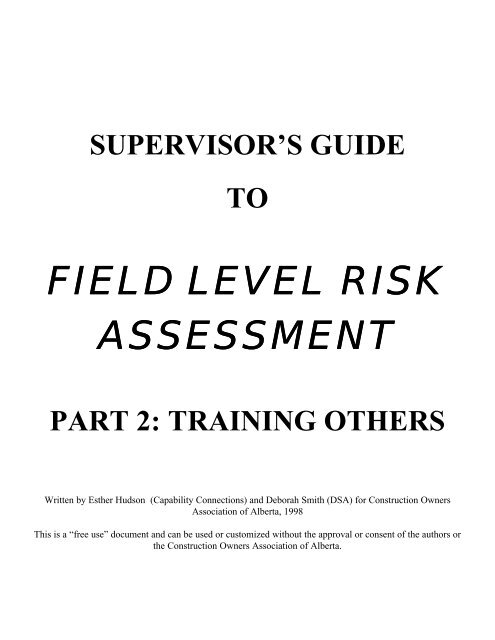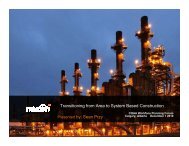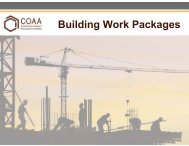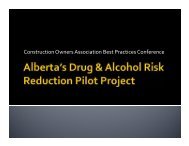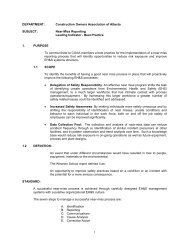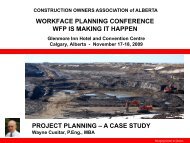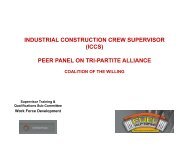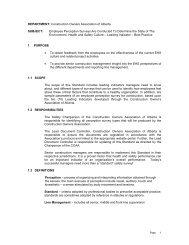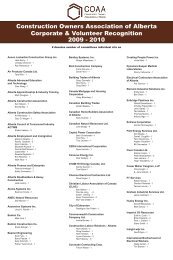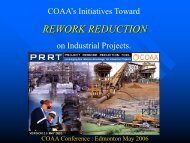field level risk assessment - Construction Owners Association of ...
field level risk assessment - Construction Owners Association of ...
field level risk assessment - Construction Owners Association of ...
You also want an ePaper? Increase the reach of your titles
YUMPU automatically turns print PDFs into web optimized ePapers that Google loves.
SUPERVISOR’S GUIDETOFIELD LEVEL RISKASSESSMENTPART 2: TRAINING OTHERSWritten by Esther Hudson (Capability Connections) and Deborah Smith (DSA) for <strong>Construction</strong> <strong>Owners</strong><strong>Association</strong> <strong>of</strong> Alberta, 1998This is a “free use” document and can be used or customized without the approval or consent <strong>of</strong> the authors orthe <strong>Construction</strong> <strong>Owners</strong> <strong>Association</strong> <strong>of</strong> Alberta.
Supervisor’s Guide to Field Level Risk Assessment: Part 2 Training OThersINTRODUCTIONField Level Risk Assessment Training for Supervisors is in two parts:Part 1 – “Supervisor’s Guide to Field Level Risk Assessment: Self -Study Training”The purpose <strong>of</strong> this training is to fully acquaint you with Field Level Risk Assessment. It will help you developthe understanding and skill that you need to use Field Level Risk Assessment and prepare you to teach others.This package can be used by anyone who would like to learn more about Field Level Risk Assessment.Part 2 – “Supervisor’s Guide to Field Level Risk Assessment – Training Others” (This document)This includes a description <strong>of</strong> the Field Level Risk Assessment Workshop and how to prepare to deliver thistraining. It includes specific lesson plans for delivering the training, information on how to customize the trainingfor your company and tips on how to deliver effective training.Additional Tools for Use in Doing Field Level Risk Assessment:The following tools have been developed to assist in doing Field Level Risk Assessment• The “Memory Jogger” card• The Risk Assessment Matrix• The Field Level Risk Assessment Form<strong>Construction</strong> <strong>Owners</strong> <strong>Association</strong> <strong>of</strong> Alberta 2
Supervisor’s Guide to Field Level Risk Assessment: Part 2 Training OThersTABLE OF CONTENTS1. Description <strong>of</strong> the Training 42. How to Prepare Yourself For Delivering the Workshop 73. Lesson Plans 94. Overhead Masters 345. How to Customize the Training 646. Tips on How to Deliver Training 677. Templates 71<strong>Construction</strong> <strong>Owners</strong> <strong>Association</strong> <strong>of</strong> Alberta 3
Supervisor’s Guide to Field Level Risk Assessment: Part 2 Training OThersDESCRIPTION OF THE TRAININGPurpose <strong>of</strong> the TrainingThe purpose <strong>of</strong> the Field Level Risk Assessment Workshop is:To prepare work site personnel to use the Field Level Risk Assessment process, in a habitual way, to identifypotential hazards, assess their magnitude, and decide if controls are needed.All <strong>field</strong> <strong>level</strong> workers on construction sites in Alberta.Target Group to be TrainedGroup Size6 to 12 participants is optimum. It is difficult to help individual workers develop skills when the group is larger.Learning Objectives <strong>of</strong> the TrainingAs a result <strong>of</strong> the course, participants will be able to:1. Identify and describe a hazard, an <strong>assessment</strong> <strong>of</strong> <strong>risk</strong>, and a control.2. Describe the process <strong>of</strong> Field Level Risk Assessment.3. List the two components <strong>of</strong> Field Level Risk Assessment.4. Identify situations where the Field Level Risk Assessment process should be used.5. Use the “Memory Jogger” questions to do a Field Level Risk Assessment.6. Use the Risk Assessment Matrix to assess the <strong>risk</strong> in a situation.7. Discuss the kinds <strong>of</strong> hazards that are possible on a work site.8. Discuss the types <strong>of</strong> controls that can be used to keep <strong>risk</strong> to an acceptable <strong>level</strong>.9. Demonstrate the ability to do Field Level Risk Assessment in a group using a case study.10. Discuss the responsibilities they have to use Field Level Risk Assessment.11. Describe how Field Level Risk Assessment will be used in this company.12. Discuss the barriers to using Field Level Risk Assessment habitually and the supports that are available toovercome these barriers.13. List the benefits <strong>of</strong> making Field Level Risk Assessment a habit on every job.<strong>Construction</strong> <strong>Owners</strong> <strong>Association</strong> <strong>of</strong> Alberta 4
Supervisor’s Guide to Field Level Risk Assessment: Part 2 Training OThersTime FormatTraining Delivery RequirementsThis workshop is divided into four lessons. The four lessons can be delivered in 1, two and one half-hour session,2 one-hour sessions, or 4 one half-hour sessions. What format you choose will depend upon what fits into yourwork scheduling the best. The two and one half-hour session includes breaks. This format uses worker timemost efficiently and provides the best learning opportunity.Shorter sessions require you to review the previous lessons before you introduce new material. There is theopportunity between the shorter sessions to practice the new skills learned in the training. This can make thetraining more effective.You can spend more time than is allocated in the lesson plans, if it is available. This will allow for morediscussion time and extra practice. More time will help you to make sure that workers have developed the <strong>level</strong><strong>of</strong> skill in Field Level Risk Assessment your company expects.Equipment/ Material Requirements• If you have access to an overhead projector and screen place them in a location that will allow goodvisibility by all participants. If you are unable to use an overhead, photocopy the overhead masters and givethem to the workers for use in the training.• A flipchart is also required. If a flipchart stand is not available tape flipchart paper on a wall. You willneed flipchart pens if you are using the flipchart.• For lessons 2 and 3, provide adequate space to allow participants to arrange themselves comfortably intogroups <strong>of</strong> 3.• The “Worker’s Guide to Field Level Risk Assessment”, has been developed for use by the workers duringthe training. This contains the “Risk Assessment Matrix” that is required during the training. Yourcompany may wish to produce this guide as a pocket-sized booklet for use after the workshop.• “Memory Jogger” cards should also be distributed to each worker during the training. The master for thiscard is in “Section 5: How to Customize the Training”.• You may wish to photocopy the Field Level Risk Assessment Form. Although supervisors, not workers,are expected to use this form, it may be useful in lesson 3 during the practice session. A master for this isalso found at the end <strong>of</strong> this document.Preparing Workers for the TrainingThe “Manager’s Handbook” provides suggestions about how to inform workers about Field Level RiskAssessment prior to delivering the training. It is important that training is not the first time that workers hearabout Field Level Risk Assessment. Field Level Risk Assessment needs to be positioned as an important tool forworker health and safety and company effectiveness, before workers come to training.If this has not occurred, it is important that you tell workers what the training is about, why it is being deliveredand where they are expected to attend. This can be done verbally or in writing.<strong>Construction</strong> <strong>Owners</strong> <strong>Association</strong> <strong>of</strong> Alberta 5
Supervisor’s Guide to Field Level Risk Assessment: Part 2 Training OThersAgenda OverviewModule One Introduction to the Field Level Risk AssessmentIntroductionsThe Need for Field Level Risk Assessment : ExamplesDescription <strong>of</strong> Field Level Risk AssessmentWhen to Use Field Level Risk AssessmentModule Two The Mental ProcessUsing the Memory JoggerHow to Do Field Level Risk AssessmentCase StudyModule Three Doing Field Level Risk AssessmentKind <strong>of</strong> Hazards and ControlsCase StudyModule Four ResponsibilitiesFit with Company Occupational Health and Safety ProgramResponsibilitiesBarriers, Supports and Benefits<strong>Construction</strong> <strong>Owners</strong> <strong>Association</strong> <strong>of</strong> Alberta 6
Supervisor’s Guide to Field Level Risk Assessment: Part 2 Training OThersHOW TO PREPARE YOURSELF FOR THE TRAINING1. Complete the Supervisor’s Guide to Field Level Risk Assessment-Part 1: Self Study TrainingThis will help you to develop your own skills in Field Level Risk Assessment. Many <strong>of</strong> the exercises in the selfstudyare also used in the worker workshop training. Completing these exercises on your own will make it easierfor you to teach others the skills.2. Read through the lesson plans.This will give you an overview <strong>of</strong> the training. It will help you assess how much preparation you will need.3. Answer the following questions about the Field Level Risk Assessment training being delivered inyour company.• Who will be trained in your company?• What will the format <strong>of</strong> the training be? One (two and half hour) session, two (one hour) sessions orfour (one half-hour) sessions?• Where will the training be conducted?• Who will you be training?• What tools are being provided by the company? The “Memory Jogger” card? The “Worker’s Guideto Field Level Risk Assessment”? The “Field Level Risk Assessment Form” with attached copies <strong>of</strong>the “Risk Assessment Matrix”?4. Develop company specific case studies to use in the training.Using real examples from the work that you do will help make the training interesting and practical. How todevelop company specific case studies for this purpose is “How to Customize the Training.”5. Add information about your company’s approach to Field Level Risk Assessment to Lesson Plan #4.The training requires you to tell workers about how your company is implementing Field Level Risk Assessment.To be able to do this, you will need to have answers to the following questions:• What is the company trying to achieve by using Field Level Risk Assessment?• Have targets been set for improvements? If so what are they?• How important is reaching these targets to the company?• How does management see Field Level Risk Assessment fitting with the current safety program?• What are the expectations <strong>of</strong> supervisors? e.g. Will filling in forms be required? Will suggestions forwork improvements?• What are the expectations <strong>of</strong> workers? e.g. Will they be required to make suggestions for workimprovements? To fill in forms in a supervisors absence?• What standards have been set for Field Level Risk Assessment? e.g. How completely should the formbe filled out? How <strong>of</strong>ten should forms be submitted and to whom? How will these be monitored?<strong>Construction</strong> <strong>Owners</strong> <strong>Association</strong> <strong>of</strong> Alberta 7
Supervisor’s Guide to Field Level Risk Assessment: Part 2 Training OThers• Will questions be asked about Field Level Risk Assessment be asked during safety audits? Duringformal performance reviews?• If forms are being used in the company, will someone review the forms?• Will there be rewards for doing Field Level Risk Assessment well?6. Make logistical arrangements for the training.• Book a suitable room for the training.• Arrange for refreshments (beverages/doughnuts).7. Prepare worker materials.• Photocopy “Worker’s Guide to Field Level Risk Assessment” or access booklets from your company.• Make copies <strong>of</strong> the overheads for workers if you are not using an overhead projector.• Access “Memory Jogger” cards or photocopy masters for each worker.8. Practice using the lesson plansBecome familiar with what the lessons require you to teach and decide how you are going to use the lessonplans. Some people like to make a shortened outline for themselves. Others make notes or highlight key ideasor actions. You may wish to adapt the lessons to your own style <strong>of</strong> delivery or the needs <strong>of</strong> the group /groupsyou are training.Three weeks before the workshop1. Read the lessons.2. Complete Part 1 – Self Study Training in Field Level Risk Assessment3. Find out about the training plans and the application <strong>of</strong> Field Level Risk Assessment in your company.4. Prepare company specific content for the training.5. Inform workers who will be attending the training about the training.One week before the workshop1. Become very familiar with the lesson plan.2. Prepare overhead transparencies.3. Photocopy “Guide to Field Level Risk Assessment”.4. Produce “Memory Jogger” cards.5. Book a room and arrange for overhead projector, screen, flipchart.6. Arrange for c<strong>of</strong>fee, juice and doughnuts.On the day <strong>of</strong> the workshop1. Set-up room with overhead projector, screen, flipchart, tables and chairs.2. Bring Lesson Plans, Overheads, Guide to Field Level Risk Assessment and “Memory Jogger” cards to room.3. Set up beverages (c<strong>of</strong>fee, juice, etc,) and doughnuts.<strong>Construction</strong> <strong>Owners</strong> <strong>Association</strong> <strong>of</strong> Alberta 8
Supervisor’s Guide to Field Level Risk Assessment Part 2: Training OthersObjectives Lesson # 1Lesson #1 – Introduction to Field Level Risk Assessment1. Identify and describe a hazard, an <strong>assessment</strong> <strong>of</strong> <strong>risk</strong> and a control.2. Describe the process <strong>of</strong> Field Level Risk Assessment.3. List the two components <strong>of</strong> Field Level Risk Assessment.4. Identify situations where the Field Level Risk Assessment process should be used.Lesson Plan #1 Introduction to Field Level Risk AssessmentTime Objective Content Method Helps00 minutesWelcome • Welcome participants to course. Invite everyoneto get c<strong>of</strong>fee or juice and doughnuts.Greet and welcome to everyone Overhead #1 –Welcome01 minutes Introduction • Introduce self. Include experience/background.• State purpose <strong>of</strong> the course “ to prepare work sitepersonnel to use Field Level Risk Assessmentprocess, in a habitual way, to identify potentialhazards, assess their magnitude, and decide ifcontrols are needed.”03 minutes Identify anddescribe a hazard,and <strong>assessment</strong> <strong>of</strong><strong>risk</strong> and a control• Read “Moving Used Building Materials” Case• Ask participants what went wrong. Get a replyfrom at least 2 or 3 people. Invite others to givetheir ideas.• Lead the discussion to the realization that theworkers didn’t recognize the hazard.• Write RECOGNIZE HAZARD on the flip chart.• Explain Hazard. A hazard is a danger topeople, property, materials or the environment.Comment: For presentations by supervisors, this will be“found time” because everyone is already acquainted.Read and Discuss Case Study Overhead #2 –Moving UsedBuildingMaterials CaseFlip chart :RecognizingHazard<strong>Construction</strong> <strong>Owners</strong> <strong>Association</strong> <strong>of</strong> Alberta 9
Supervisor’s Guide to Field Level Risk Assessment Part 2: Training OthersTime Objective Content Method Helps15 minutes Describe the process<strong>of</strong> Field Level RiskAssessment• Read “Removal <strong>of</strong> the Heat Exchanger” Case• Ask participants what went wrong. Get a replyfrom at least 2 or 3 people. Invite others to givetheir ideas.• Lead the discussion to the realization that theworker didn’t realize how serious the hazard wasand failed to steps to control it.• Write ASSESS RISK on the flip chart.• Explain that when we assess a hazard we areassessing <strong>risk</strong>, considering the possibleconsequences <strong>of</strong> a hazard and how likely it is tohappen.• Read the “ Removal <strong>of</strong> the Rope Sling” Case• Ask participants what went wrong. Get a replyfrom at least 2 or 3 people. Invite others to givetheir ideas.• Lead the discussion to the realization that therehad been a change in the plan. Another workerhad been added. Additional hazards had not beenidentified. The <strong>risk</strong> was not assessed andadequate controls were not put into place.• Write CONTROL RISK on the flipchart• Explain the term “controls”. Controls areactions aimed at reducing <strong>risk</strong>s to <strong>level</strong>s that areacceptable.• State that Field Level Risk Assessment is asimple process, carried out every day on every jobby every person working there. It is a way toidentify hazards, assess the seriousness <strong>of</strong> the<strong>risk</strong>s and control the <strong>risk</strong>.Read and Discuss Case Study Overhead#3 Removal <strong>of</strong>the HeatExchangerTube CaseFlip chart -Assess RiskRead and Discuss Case Study Overhead#4 Removal <strong>of</strong>the Rope SlingCaseFlip chart -Control RiskIntroduce the Field Level RiskAssessment ModelOverhead#5 Field LevelRiskAssessment Is:<strong>Construction</strong> <strong>Owners</strong> <strong>Association</strong> <strong>of</strong> Alberta 10
Supervisor’s Guide to Field Level Risk Assessment Part 2: Training OthersTime Objective Content Method Helps15 minutes List the twocomponents <strong>of</strong> FieldLevel RiskAssessment (teamand individual)• State that :• It does not replace other safe work planning.• It adds information about new hazards or “day<strong>of</strong> the job hazards”.• It is done each time something changes.• It involves identifying each step associated withthe job,• It involves identifying the hazards associatedwith each step.• For each hazard, the crew determines howserious the <strong>risk</strong> is.• Then they decide how it will be controlled.Comment: Emphasize this information.• Hand out the “Memory Jogger” cards.State that the process requires periodicallystopping and thinking about what’s going on orwhat’s about to happen. Refer to the five steps <strong>of</strong>the model on the front <strong>of</strong> the card.• State that the team part is done by the wholecrew – together – on the day <strong>of</strong> the job – beforethe job starts.• State that the foreman writes the informationgenerated by the crew on the form and the form isposted where everyone can refer to it.Discuss Elements <strong>of</strong> the Model Overhead#6 Field LevelRiskAssessmentUse the Memory Jogger card to reviewthe Field Level Risk Assessment ProcessMemoryJogger CardPresent the Team Part <strong>of</strong> Model Overhead#7 The TeamPart. Overhead #8Field LevelRiskAssessmentForm<strong>Construction</strong> <strong>Owners</strong> <strong>Association</strong> <strong>of</strong> Alberta 11
Supervisor’s Guide to Field Level Risk Assessment Part 2: Training OthersTime Objective Content Method Helps23 minutes Identify situationswhere Field LevelRisk Assessmentshould be used• State that each individual does their own FieldLevel Risk Assessment as a mental process whilethey are working. State that, like the team part, itinvolves identifying the individual tasks to be doneand the hazards associated with each task,assessing how serious the hazards are, andchecking to be sure you’re using the appropriatecontrols. It’s an individual, mental process.Comment: Emphasize this information• Ask, “What are some examples <strong>of</strong> situationswhere there were hazards that could not have beenpredicted before we got on site? (Have somespecific examples <strong>of</strong> your own ready to get thegroup started.)• Ask, “What would be different in those situationsif we did Field Level Risk Assessment?” (Wewould work more safely and probably save time).• Ask, “When should we do Field Level RiskAssessment? Expect to hear at least thefollowing:• At the beginning <strong>of</strong> every job• At the beginning <strong>of</strong> every shift• Whenever conditions change, such asnew personnel involved in the job, weatherchanges, equipment breaks down, etc.• When participating in the “group part”• If any <strong>of</strong> these are not mentioned by theparticipants, add them as suggestions <strong>of</strong> yourown.Present the Mental Process <strong>of</strong> FieldLevel Risk AssessmentApply Field Level Risk Assessment tocurrent company work situationsOverhead#9 IndividualPartWorker’sGuide to FieldLevel RiskAssessmentpage 6<strong>Construction</strong> <strong>Owners</strong> <strong>Association</strong> <strong>of</strong> Alberta 12
Supervisor’s Guide to Field Level Risk Assessment Part 2: Training OthersTime Objective Content Method Helps29 minutes Direct participantsto the benefits <strong>of</strong>Field Level RiskAssessment• Ask participants if they can see any benefits tothis process.• Record the participants’ ideas about benefits onthe second flip chart.• Expect to hear things like: Less likely to get hurt• Get job done, more efficiently, faster, right, etc.• Note this step occurs in each <strong>of</strong> the lessons as areview and a way <strong>of</strong> checking on workers feelings.It should a brief discussion until the end <strong>of</strong> thefourth lesson.30 minutes END • Encourage workers to try to “stop and think”while they are doing work.Used only for the four session format Flip ChartBenefitsUsed only for the four session format<strong>Construction</strong> <strong>Owners</strong> <strong>Association</strong> <strong>of</strong> Alberta 13
Supervisor’s Guide to Field Level Risk Assessment Part 2: Training OthersLesson #2 – The Mental ProcessObjectives Lesson #21. Use the Memory Jogger questions to do a Field Level Risk Assessment.2. Use the Risk Assessment Matrix to assess the <strong>risk</strong> in a situation.Lesson Plan #2 – The Mental ProcessTime Objective Content Method Helps00 minutes Welcome • Welcome participants to the course. Inviteeveryone to get c<strong>of</strong>fee, juice and doughnuts.Greeting/Announcement Overhead#1 Welcome01 minute Review the FieldLevel RiskAssessment Model• Ask “ What is Field Level Risk Assessment?”Response should include: A way <strong>of</strong> identifyinghazards, assessing how serious the <strong>risk</strong> is andidentifying ways <strong>of</strong> controlling the <strong>risk</strong>. Ithappens on the day <strong>of</strong> the job and is done by theteam and by individuals.• Direct participants to take out their MemoryJogger cards. If participants don’t have their“Memory Jogger” card with them, give them anew one.Optional : Use in four session formatonlyOverhead#5 Field LevelRiskAssessment IsMemoryJogger cards<strong>Construction</strong> <strong>Owners</strong> <strong>Association</strong> <strong>of</strong> Alberta 14
Supervisor’s Guide to Field Level Risk Assessment Part 2: Training OthersTime Objective Content Method HelpsUse the MemoryJogger questions todo a Field LevelRisk Assessment.• Explain that we are going to practice the skillsneeded to do an effective Field Level RiskAssessment. We are going to use the questions onthe back <strong>of</strong> the Memory Jogger to help. We willwork through a case study to practice the skills.All <strong>of</strong> the questions we will be discussing arefound in the Worker’s Guide to Field Level RiskAssessment.Introduction to the back side <strong>of</strong> the“Memory Jogger”MemoryJogger orWorker’sGuide to FieldLevel RiskAssessment.Page 7-9• Read the questions used to identify hazards onthe back <strong>of</strong> Memory Jogger.There are really 2 things to be identified:a) the individual tasks involved in each job, and b)the hazards associated with each task.Usually, each individual task will have specifichazards associated with it.• Read “Fluorescent Lamp Case” using theoverhead. Note: A company specific case studycan be used here. See the section “How toCustomize the Training” in this manual to learnhow to develop a case study. The FluorescentLamp Case was used in Supervisor’s Guide toField Level Risk Assessment Part 1: Self-StudyTraining. You may wish to refer to this duringyour preparations.Review Questions Overhead#10 IdentifyingHazardsPresent Case Study Overhead#11FluorescentLamp Case<strong>Construction</strong> <strong>Owners</strong> <strong>Association</strong> <strong>of</strong> Alberta 15
Supervisor’s Guide to Field Level Risk Assessment Part 2: Training OthersTime Objective Content Method HelpsUse the MemoryJogger questions todo a Field LevelRisk Assessment• Read the first question on the back <strong>of</strong> theMemory Jogger and/or the overhead:Do I clearly understand my job for the day? Whatexact job am I doing, and what specific tasks does itinvolve?• Ask “ What are the job steps (tasks) that it takesto replace a light bulb? Help the group identifythese steps and record them on the flipchart or onthe blank overheadRead first question “MemoryJogger” or“WorkerGuide to FieldLevel RiskAssessment”page 7Overhead#12 IdentifyHazards-QuestionsLead a Group Discussion <strong>of</strong> Job Stepsand record steps on a the flipchart or theoverheadFlipchart:Job Steps<strong>Construction</strong> <strong>Owners</strong> <strong>Association</strong> <strong>of</strong> Alberta 16
Supervisor’s Guide to Field Level Risk Assessment Part 2: Training OthersTime Objective Content Method Helps• Identify the hazards. Explain that we will usethe questions to identify the hazards in each jobstep. You may wish to read all <strong>of</strong> the questionsand then ask what hazards are linked with the jobsteps we identified or ask what hazards first. Thehazards that the group may identify are (You canjust read and discuss these from the overhead):• Working at elevation• Dust disturbance (eyes and breathing)• Electrical hazard• Breaking glass (bulb and fixture cover)• Other workers or traffic below• Eye / muscle strain from poor lightingLead a discussion to identify the hazardsin the case studyOverhead#13 Hazardsfor Replacing aFluorescentLampUse the MemoryJogger questions todo a Field LevelRisk Assessment.Note: Some hazards are there because <strong>of</strong> the nature<strong>of</strong> the job e.g. electrical hazard. Some are therebecause <strong>of</strong> the specific situation where this work isbeing done i.e. poorly lit and busy hallway. Theseconditions would not have been predicted in a job plan.Use this to emphasize the “day <strong>of</strong> the job” conditionsidentified in Field Level Risk Assessment.Am I physically and mentally prepared to do eachtask? Am I strong enough to do each <strong>of</strong> the tasksinvolved in this job? Do I know how to do them? Do Ihave the individual tasks that need to be done, and theway I’m going to do them, clear in my mind?What could go wrong? What could happen to upsetmy plan for the way I will do each individual task?Present and Discuss These Questions Overhead:#12 IdentifyHazardQuestionsPresent and Discuss These Questions<strong>Construction</strong> <strong>Owners</strong> <strong>Association</strong> <strong>of</strong> Alberta 17
Supervisor’s Guide to Field Level Risk Assessment Part 2: Training OthersTime Objective Content Method HelpsUse the MemoryJogger questions todo a Field LevelRisk Assessment.Is there danger to myself or others? to the equipment?to the environment? Any potential danger is a hazard.What could change and create a new hazard? Theprocedure you have in your head will allow you to doeach task safely. What could happen to interfere withthat procedure?Could other crews, workers, or conditions posehazards to me? Others will go through the samemental process, and decide how to control the hazardsthey’ve identified, but will work cause a hazard to you?• Ask “What would be the result if our crew usedthese questions on a regular basis. Expect somenegative responses like it would take more timeand positive responses like, we would work moresafely.Present and Discuss These QuestionsPresent and Discuss These QuestionsPresent and Discuss These QuestionsLead a Discussion About Using TheseQuestions<strong>Construction</strong> <strong>Owners</strong> <strong>Association</strong> <strong>of</strong> Alberta 18
Supervisor’s Guide to Field Level Risk Assessment Part 2: Training OthersTime Objective Content Method Helps15 minutes Use the MemoryJogger questions todo a Field LevelRisk Assessment.• Review the questions used to assess <strong>risk</strong>s. Restateeach question while pointing to it. Each <strong>of</strong>these questions has to be asked about each hazardthat has been identified.How serious could this be? Cause someone to break abone, damage the equipment contaminate the soil,cause a death, slow down the work, etc.? Do youconsider it to be serious, moderate or minor?Review the Assess Risk Questions Overhead#14 AssessingRiskQuestionsHow likely is it to happen? Is it almost certain tohappen, pretty likely to happen, almost impossible, notvery likely, etc.? Do you expect it to happen <strong>of</strong>ten,sometimes, or rarely?Explain the terms on the Risk Assessment Matrix• The seriousness – how serious could be this be– iscalled consequences. H designates seriousconsequences. M designates moderateconsequences. And L designates minorconsequences. Point to the letters, “H”, “M”, and“L” on the Risk Assessment Tool as you describethem.• The likelihood – how likely it is to happen – iscalled probability. Something that could occur<strong>of</strong>ten, is coded as H. Something that willsometimes occur, is coded as M. Something thatwill rarely occur, is coded as L. Point to theletters, “H”, “M”, and “L” on the Risk AssessmentTool as you describe them..Explain the Risk Assessment MatrixOverhead# 15The RiskAssessmentMatrix<strong>Construction</strong> <strong>Owners</strong> <strong>Association</strong> <strong>of</strong> Alberta 19
Supervisor’s Guide to Field Level Risk Assessment Part 2: Training OthersTime Objective Content Method HelpsUse the MemoryJogger questions todo a Field LevelRisk Assessment.• Review the use <strong>of</strong> the Risk Assessment Matrix.• Trace the “mental lines” on the overhead as youexplain them. “Find the code for the consequencesand the probability along the left side and the top<strong>of</strong> the Risk Assessment Tool. Draw a mental lineacross the diagram from the consequences codeand down the diagram from the probability code.The point where they meet is the code for the<strong>assessment</strong> <strong>of</strong> the <strong>risk</strong> associated with thisparticular hazard.”• Point to the <strong>risk</strong> <strong>assessment</strong> codes, H, M, and L, inthe bottom right hand nine squares <strong>of</strong> the tool.H means high <strong>risk</strong>; M means medium <strong>risk</strong>;L means low <strong>risk</strong>.• The outcome <strong>of</strong> the <strong>risk</strong> <strong>assessment</strong> will help todetermine the most appropriate kind <strong>of</strong> controls touse.• Ask “ What is the <strong>level</strong> <strong>of</strong> <strong>risk</strong> associated witheach hazard in the ‘ Replacing a Light Bulb’ casestudy?”• You may wish to use the blank overhead and havethe group assess the <strong>level</strong> <strong>of</strong> <strong>risk</strong> or you candiscuss the <strong>assessment</strong> that the is on the overhead.• While using the overhead, direct participants touse the Risk Assessment Matrix in the Worker’sGuide to Field Level Risk Assessment Page 8.• Ask “ What would be the result if we used thismethod <strong>of</strong> assessing <strong>risk</strong> while we are doingwork?”Demonstrate the Use <strong>of</strong> the RiskAssessment MatrixLead a Discussion using the RiskAssessment MatrixLead a Discussion About Using the RiskAssessment MatrixOverhead#15 RiskAssessmentMatrixOverhead#16 and #17Assessing Riskin Replacing aFluorescentLamp (blankand theanswers)Worker’sGuide to FieldLevel RiskAssessmentPage 8<strong>Construction</strong> <strong>Owners</strong> <strong>Association</strong> <strong>of</strong> Alberta 20
Supervisor’s Guide to Field Level Risk Assessment Part 2: Training OthersTime Objective Content Method Helps23 minutes Use the MemoryJogger questions todo a Field LevelRisk Assessment.• Review the questions used for ensuring control<strong>of</strong> <strong>risk</strong>. Many controls are dictated by standardoperating procedures, codes <strong>of</strong> practice, permitrequirements, job plans, etc. Others are decidedat team meetings. And some are decided byindividual workers when they set out to perform atask.Are permits, written practices, procedures, etc.required? If so, take immediate steps to meet theserequirements.What can I do to control the hazard? Have youfollowed all the required steps in the procedure, code <strong>of</strong>practice, permit, job plan, etc.? Are there any othercontrols that you think are needed?Will the control affect another part <strong>of</strong> the task beingdone? Think about the tasks being performed by youand others. The control <strong>of</strong> one hazard may be thecause <strong>of</strong> another. If you think the controls in placemay have a negative effect to some other part <strong>of</strong> thework, you may have to contact the supervisor.Do I need to tell anyone else? Is there anyone elsewho may be affected by the controls you’re using? Isthere a need for coordination <strong>of</strong> tasks done by morethan one person?Is there someone I could call for help? Who has theknowledge and skill to help me?Review the “Control <strong>of</strong> Risk” questions Overhead #18ControllingRisk Questions<strong>Construction</strong> <strong>Owners</strong> <strong>Association</strong> <strong>of</strong> Alberta 21
Supervisor’s Guide to Field Level Risk Assessment Part 2: Training OthersTime Objective Content Method HelpsUse the MemoryJogger questions todo a Field LevelRisk Assessment.Direct participantsto identify thebenefits <strong>of</strong> FieldLevel RiskAssessment• Review the questions used for ensuring Control<strong>of</strong> Risk. (continued)Are emergency response plans needed? If theidentified hazard has a potential for “highconsequences”, emergency procedures may be needed.• Ask participants if they can see any benefits to thisprocess.• Record the participants’ ideas about benefits on theflip chart.• Expect to hear things like: Less likely to get hurtGet job done, more efficiently, faster, right, etc.• Note this step occurs in each <strong>of</strong> the lessons as areview and a way <strong>of</strong> checking on workers ‘feelings.It should a brief discussion until the end <strong>of</strong> thefourth lesson.30 minutes END/ Break • Encourage workers to use the questions on theback <strong>of</strong> their memory jogger card at least once inbefore the next session.Review the “Control <strong>of</strong> Risk” questions Overhead #18ControllingRisk QuestionsUse this in the two and /or four sessionversionsUse only in the two or four sessionformatTake a break in the one session formatFlipchart:Benefits<strong>Construction</strong> <strong>Owners</strong> <strong>Association</strong> <strong>of</strong> Alberta 22
Supervisor’s Guide to Field Level Risk Assessment Part 2: Training OthersObjectives:Lesson #3 – Doing Field Level Risk Assessment1. Discuss the kinds <strong>of</strong> hazards that are possible on a work site.2. Discuss the types <strong>of</strong> controls that can be used to keep <strong>risk</strong> to an acceptable <strong>level</strong>.3. Demonstrate ability to do Field Level Risk Assessment in a group using a case study.Resources Required:This lesson requires a case study example using work with which your group is familiar . To prepare for this exercise read “ How to Customize theTraining” section. The lesson plan asks for this case study to be made into an overhead. If this is not possible, post in on a flipchart. There is also ageneric case study for you to use if you are unable to develop your own.Time Objective Content Method Helps00 minutes Welcome • Welcome participants to the course. Inviteeveryone to get c<strong>of</strong>fee, juice and doughnuts.Greeting/Announcement Overhead #1 -WelcomeReview Field LevelRisk AssessmentMental Process• Introduce the exercise by saying that we aregoing to practice doing Field Level RiskAssessment using another case study. This willalso give us the opportunity to test what we havealready learned. We will also be learning moreabout kinds <strong>of</strong> hazards and types <strong>of</strong> controls• Ask, “ What is the first step in doing a FieldLevel Risk Assessment on the work site?” Thegroup may respond with either meet as a crew tohave a discussion or stop and think. Bothresponses are correct and should be reinforced.One represents an understanding <strong>of</strong> the teamprocess and the other the mental process.Review content <strong>of</strong> previous sessions. Usefor all formatsOverhead#6 Field LevelRiskAssessment(Optional)<strong>Construction</strong> <strong>Owners</strong> <strong>Association</strong> <strong>of</strong> Alberta 23
Supervisor’s Guide to Field Level Risk Assessment Part 2: Training OthersTime Objective Content Method Helps. • Ask, “What is the next step?” Identify theHazards. How do you identify the hazards?Identify job steps and the hazards associatedwith each step.05 minutes Discuss the kinds <strong>of</strong>hazards that arepossible on a worksite.• Ask, “What kind <strong>of</strong> hazards should we belooking for? Record group’s ideas on theflipchart.• Compare their list with the list on the overhead.These include equipment, heights, trenches, heat,cold, electricity, explosions, fires, radioactivity,chemicals, noise, muscle strains, microbes, sharpobjects, vibration, stress, and many more. Givespecific examples from the work that you do.• Ask, “ What is the next step after we identify thehazards?” We assess the <strong>risk</strong>.• Ask, “How do we assess <strong>risk</strong>?” The seriousnessand the likelihood <strong>of</strong> each hazard has to beassessed. The Risk Assessment Tool can be usedto determine the degree <strong>of</strong> <strong>risk</strong>• Ask, “ Why is it important to identify the degree<strong>of</strong> <strong>risk</strong> for each hazard?” We need to put controlsin place for all hazards that represent a high ora medium <strong>level</strong> <strong>of</strong> <strong>risk</strong>.Discuss the steps <strong>of</strong> Field Level RiskAssessmentPresent and Discuss kinds <strong>of</strong> hazards Overhead#19Kinds <strong>of</strong>Hazards<strong>Construction</strong> <strong>Owners</strong> <strong>Association</strong> <strong>of</strong> Alberta 24
Supervisor’s Guide to Field Level Risk Assessment Part 2: Training OthersDiscuss the types <strong>of</strong>controls that can beused to keep <strong>risk</strong> toan acceptable <strong>level</strong>.10 minutes Demonstrate abilityto do Field LevelRisk Assessment in agroup using a casestudy.• “We are going to learn more about types <strong>of</strong>controls. Lets make a list <strong>of</strong> controls that we useon a regular basis” Record their ideas on theflipchart.• Present the material about types <strong>of</strong> controlsusing the overhead. Provide examples <strong>of</strong> types <strong>of</strong>controls from the work that participants do. Useexamples from the list. Emphasize the need touse the right controls for the <strong>level</strong> <strong>of</strong> <strong>risk</strong>. High<strong>risk</strong> hazards require very tight controls. Thetypes <strong>of</strong> controls include:• Engineering controls, such assubstitution, elimination, guards, other processenclosures, automatic shutdown devices, andventilation.• Administrative controls, such as permitsand procedures, and work scheduling tominimize the number <strong>of</strong> workers exposed.• Personal protective equipment such asfall protection, ear plugs and safety goggles.• Introduce the case study exercise by saying thatit is now time to practice.• Read the case study.• Follow the steps just discussed. Make surethat you record the following information on aflipchart: The job steps, the hazards associatedwith each step, the <strong>risk</strong> (using the RiskAssessment Matrix) and the controls for eachhazard with a medium or high <strong>level</strong> <strong>of</strong> <strong>risk</strong>. Theanswers for the #22 Practice Case Study arefound in the “ How to Customize the Trainingsection.Present information on types <strong>of</strong> controls Overhead #20Types <strong>of</strong>ControlsDo a Field Level Risk Assessment in alarge group discussionOverhead#21 CompanyCase #1 or #22Practice CaseStudy #1# 15 RiskAssessmentMatrixFlipchart:The job steps,the hazards, the<strong>assessment</strong> <strong>of</strong><strong>risk</strong>, thecontrols<strong>Construction</strong> <strong>Owners</strong> <strong>Association</strong> <strong>of</strong> Alberta 25
Supervisor’s Guide to Field Level Risk Assessment Part 2: Training Others25 minutes Demonstrate ability • Ask, “What is the most difficult part <strong>of</strong> the doingto do Field Level Field Level Risk Assessment?” What went well?”Risk Assessment in a These questions allow you to check howgroup using a case individuals are feeling about doing Field Levelstudy.Risk Assessment. It will also help you to identifyareas where more coaching may be needed..30 minutes END this section • Encourage workers do a <strong>field</strong> <strong>level</strong> <strong>risk</strong><strong>assessment</strong> at least once before the next sessionLarge group discussion about theexerciseUse only with the four session format<strong>Construction</strong> <strong>Owners</strong> <strong>Association</strong> <strong>of</strong> Alberta 26
Supervisor’s Guide to Field Level Risk Assessment Part 2: Training OthersObjectives:Lesson Plan #4 – Responsibilities1. Discuss the responsibilities they have to use Field Level Risk Assessment.2. Describe how Field Level Risk Assessment will be used in this company.3. Discuss the barriers to using Field Level Risk Assessment habitually and the supports that are available to overcome these barriers.4. List the benefits <strong>of</strong> making Field Level Risk Assessment a habit on every job.5. Demonstrate ability to do Field Level Risk Assessment in a group using a case study. (optional)Time Objective Content Method Helps00 minutes Welcome • Welcome participants to the course. Inviteeveryone to get refreshments (beverage anddoughnuts)Use only in the four session format Overhead#1 WelcomeReview key pointsfrom last lesson• Ask, “Did anyone try to do a Field Level RiskAssessment since last session? Could you tell usabout it? How was it to do? What went well?What was difficult?” Facilitate the discussion ifthere is a positive response to this question. Ifthere is not a positive response review keyconcepts from last lesson i.e. types <strong>of</strong> controls,kinds <strong>of</strong> hazards.Use only in the four session format<strong>Construction</strong> <strong>Owners</strong> <strong>Association</strong> <strong>of</strong> Alberta 27
Supervisor’s Guide to Field Level Risk Assessment Part 2: Training OthersTime Objective Content Method Helps5 minutes Discuss theresponsibilities theyhave to use FieldLevel RiskAssessment.• Present the responsibilities outlined in theOccupational Health and Safety Act. Explain thateveryone on the site is responsible foroccupational health and safety.• Alberta’s Occupational Health and Safety Acttells who’s responsible for what in work sitehealth and safety. The Act says that workers have3 specific responsibilities. They are:Presentation about responsibilitiesoutlined in the Health and Safety ActOverhead#23 Health andSafetyResponsibilities• Do every thing they reasonably can toprotect their own and other workers’ healthand safety on the job.• Cooperate with their employer’s effortsto protect their own and other workers’ healthand safety on the job.• Refuse to do unsafe work.• Ask, “How does Field Level Risk Assessmenthelp workers to fulfill these legalresponsibilities?” Answers should includeeveryone is thinking about hazards, assessing the<strong>risk</strong> and putting controls. This makes sure thateveryone is working safely. Since the company isdoing this and making it a part <strong>of</strong> the health andsafety program they are acting on theirresponsibility to make sure that people areworking safely. Crew discussions are part <strong>of</strong>this.<strong>Construction</strong> <strong>Owners</strong> <strong>Association</strong> <strong>of</strong> Alberta 28
Supervisor’s Guide to Field Level Risk Assessment Part 2: Training OthersTime Objective Content Method Helps10 minutes Describe how FieldLevel RiskAssessment will beused in thiscompany. (Thissection can be replacewith a case study.)• Ask, “Why do you think our company isimplementing Field Level Risk Assessment?Response could include their legalresponsibilities, to lower injuries, saveequipment costs, improve how we work etc.)• Present information about the company’s FieldLevel Risk Assessment initiative. Answer thefollowing questions :• What is the company trying to achieveby using Field Level Risk Assessment?• Have targets been set for improvements?If so what are they?• How important is reaching these targetsto the company? (Record the points you aregoing to present below.)Present information about the company’sField Level Risk Assessment InitiativeOverheadDevelop theoverheads thatyou need topresent thecompanyinformation.Record thenumbers andtitles here.(see Overhead#28)• How does management see Field LevelRisk Assessment fitting with the current safetyprogram? (Record the points you are going topresent below.)<strong>Construction</strong> <strong>Owners</strong> <strong>Association</strong> <strong>of</strong> Alberta 29
Supervisor’s Guide to Field Level Risk Assessment Part 2: Training OthersTime Objective Content Method Helps• What are the expectations <strong>of</strong>supervisors? e.g. Will filling in forms berequired? Submit suggestions for workimprovements? (Record the points you aregoing to present below.)• What are the expectations <strong>of</strong> workers?Make suggestions for work improvements?(Record the points you are going to presentbelow.)Present information about the company’sField Level Risk Assessment InitiativeOverheadDevelop theoverheads thatyou need topresent thecompanyinformation.Record thenumbers andtitles here.• What standards about Field Level RiskAssessment been set? If yes, what are they?e.g. How completely should the form be filledout? How <strong>of</strong>ten should form be submitted andto whom? How will these be monitored?(Record the points you are going to presentbelow.)<strong>Construction</strong> <strong>Owners</strong> <strong>Association</strong> <strong>of</strong> Alberta 30
Supervisor’s Guide to Field Level Risk Assessment Part 2: Training OthersTime Objective Content Method Helps10 minutes Demonstrate abilityto do Field LevelRisk Assessment in agroup using a casestudy. (optional)• Will questions be asked about Field LevelRisk Assessment be asked during safety audits?Formal performance reviews? (Record the pointsyou are going to present below.)• If time permits or there is little to say about thecompany’s initiative, direct the participants to doa case study in teams <strong>of</strong> three . Use a case studythat you have developed (Company Case #2) orthe Practice Case #2 that has been provided.Note: This is practice <strong>of</strong> the “Team Part” <strong>of</strong> theprocess. You will need to prepare another companycase study using work that is familiar to yourparticipants. See “How to Customize Training” forhow this is to be done• Each team needs to:• Identify the tasks to be performed• Identify the hazards associated with eachtask,• Assess the <strong>risk</strong> associated with eachhazard• Identify appropriate controls for eachhigh and medium <strong>risk</strong>• Direct the teams to record their ideas to each <strong>of</strong>the four points. You may choose to give eachgroup a hard copy <strong>of</strong> the overhead, blank paper,or a copy <strong>of</strong> the Field Level Risk AssessmentForm for this purpose.Present information about the company’sField Level Risk Assessment InitiativeDirect Group to do a Case study(optional)OverheadDevelop theoverheads thatyou need topresent thecompanyinformation.Record thenumbers andtitles here.Overhead#24 Companycase #2 or #25Practice CaseStudy #2<strong>Construction</strong> <strong>Owners</strong> <strong>Association</strong> <strong>of</strong> Alberta 31
Supervisor’s Guide to Field Level Risk Assessment Part 2: Training OthersTime Objective Content Method Helps20 minutes Discuss the barriersto using Field LevelRisk Assessmenthabitually and thesupports that areavailable toovercome thesebarriers.• Check their work either in a large groupdiscussion by asking the following questions:• What tasks need to be performed?• What are the hazards associated witheach task?• What is the <strong>risk</strong> associated with eachhazard?• What controls did you put in place?”Stress that they are only doing “day <strong>of</strong> the job”conditions, not an entire safe work plan. You musthave developed the “right” answers as part <strong>of</strong> yourpreparation.• Ask, “What will stop the company and you frombeing successful at using Field Level Risk<strong>assessment</strong>? Ensure that the discussion bringsout ideas like – time to do <strong>assessment</strong> and havediscussions, the habits we have <strong>of</strong> just workingwithout thinking about hazards first, the cost <strong>of</strong>better controls, lack <strong>of</strong> knowledge about controlsand <strong>risk</strong>s, concern about speaking out to makesuggestions, stop work etc. Record the barrierson the flipchart.• Ask, “What support do you need to do FieldLevel Risk Assessment on a habitual basis?Responses may include : to know that thecompany is serious, that I won’t get into troubleif I stop work, that making suggestions is worththe effort, other crew members to do it too,having the supervisor remind me to do it, havethe supervisor hold the discussions, morepractice do it etc. Record the ideas on aflipchart.Case study exercise See case studyanswers thatfollow thelesson plansLead a discussion about barriers to usingField Level Risk Assessment and thesupports that are available.FlipchartBarriers,Supports<strong>Construction</strong> <strong>Owners</strong> <strong>Association</strong> <strong>of</strong> Alberta 32
Supervisor’s Guide to Field Level Risk Assessment Part 2: Training OthersTime Objective Content Method Helps25 minutes List the benefits <strong>of</strong>using Field LevelRisk Assessmenthabitually• Ask, “ How will you get what you need to dothis?. Responses should include: Asksupervisors, other crew members, exerting myown effort etc. Emphasize what the company willdo to help. Also emphasize the need for personaleffort and commitment.• Ask, “What are the benefits <strong>of</strong> doing Field LevelRisk Assessment for you? For the Company?Record the ideas on the flipchart.• Present the benefits <strong>of</strong> using Field Level RiskAssessment using the overhead. The same pointsare in the Worker’s Guide to Field Level RiskAssessment. Emphasize the need to use thisprocess on a habitual basis.• Encourage participants to continue to developthe skills required to achieve these benefits.Lead a discussionDiscuss and present information aboutthe benefits <strong>of</strong> Field Level RiskAssessmentOverhead#26 Benefits(Workers)#27 Benefits(Company)30 minutes END<strong>Construction</strong> <strong>Owners</strong> <strong>Association</strong> <strong>of</strong> Alberta 33
#1WELCOME TO:FIELD LEVEL RISKASSESSMENTWORKSHOP<strong>Construction</strong> <strong>Owners</strong> <strong>Association</strong> <strong>of</strong> Alberta 34
#2“Moving Used Building Materials”CaseA crew <strong>of</strong> two was engaged in laying anelectrical cable in the yard <strong>of</strong> a largeindustrial building under renovation. Thefirst step <strong>of</strong> the safe work plan called for theremoval <strong>of</strong> some used building materialsthat had been piled where the trench neededto be dug.The crew identified the need to wear goodgloves and coveralls to protect them frombroken glass and other sharp edges. Afterthey had been working for some time andthe pile was almost all loaded on the flatbed,the supervisor arrived on site. He examinedthe material on the flatbed and identified aquantity <strong>of</strong> material that appeared to beasbestos, in the refuse that had been loaded.<strong>Construction</strong> <strong>Owners</strong> <strong>Association</strong> <strong>of</strong> Alberta 35
#3“Removal <strong>of</strong> a Heat ExchangerTube” Case”A heat exchanger tube was being removedfrom a heat exchanger in refinery area. Acrane operator and two riggers are on thecrew.The lift was in a fairly tight area. There wasa variety <strong>of</strong> equipment close to the heatexchanger.The crew reviewed the safe work plan thathad identified the following hazards: lack <strong>of</strong>communications, rigging pinch points,objects in the swing path, and visibility.<strong>Construction</strong> <strong>Owners</strong> <strong>Association</strong> <strong>of</strong> Alberta 36
#3bThe crew had decided to use radiocommunication rather than hand signalsbecause <strong>of</strong> the visibility problem.They planned the swing path and checkedthe weight calculations carefully. They usedthe required method to restrict area accesson three sides <strong>of</strong> the heat exchanger. Thefourth side appeared to have no possibility<strong>of</strong> traffic.Everything proceeded as planned until amaintenance worker entered the lift areathrough the unsigned area. He had come todo a regular equipment check. His suddenappearance momentarily distracted theoperator and the crane came in contact withan adjacent piece <strong>of</strong> equipment causingserious damage.<strong>Construction</strong> <strong>Owners</strong> <strong>Association</strong> <strong>of</strong> Alberta 37
#4“Removal <strong>of</strong> a Rope Sling” CaseA crew was unloading cable from a pickertruck flatbed. There were two people doingthe job as was required in the job plan for aheavy lift. The plan had included carefulpositioning <strong>of</strong> both workers. All had goneaccording to the plan.Another worker on site noticed that the twowere having some difficulty removing thetwo and a half-inch wire rope sling from thecrane hook and came to assist them.While working together, the rope slingstruck the third worker. This worker wasinjured seriously, having a broken nose, andcuts to his lower lip requiring 8 stitches.<strong>Construction</strong> <strong>Owners</strong> <strong>Association</strong> <strong>of</strong> Alberta 38
#5Field Level RiskAssessment is:• A simple process carried out everyday, by every crew and everyworker, on every job.• A way <strong>of</strong> identifying hazards,assessing <strong>risk</strong> and controlling <strong>risk</strong>.<strong>Construction</strong> <strong>Owners</strong> <strong>Association</strong> <strong>of</strong> Alberta 39
#6Field Level RiskAssessment:• Does not replace other safe workplanning• Adds information about “day <strong>of</strong>the job” hazards• Is done every time somethingchanges.• Involves identifying each step <strong>of</strong>the job, the hazards associatedwith each step, how likely andserious the <strong>risk</strong> is, and how the<strong>risk</strong> can be controlled.<strong>Construction</strong> <strong>Owners</strong> <strong>Association</strong> <strong>of</strong> Alberta 40
# 7The Team Part• Done by the crew and theforeman• Done on the day <strong>of</strong> the job,before the job begins and whenconditions or plans change• Crew does the same process(thinking/ mental) individuals do,together• Documented<strong>Construction</strong> <strong>Owners</strong> <strong>Association</strong> <strong>of</strong> Alberta 41
#8Field Level Risk AssessmentFormFIELD LEVEL RISK ASSESSMENTDATE: _____ ______________LOCATION:PROJECT NAME:COMPANY:STEP 1 – IDENTIFY MAIN JOB TASKS STEP 2 – IDENTIFY HAZARDS STEP 3 – ASSESS RISK(RISK = CONSEQUENCE X PROBABILITYSTEP 4 – CONTROL RISKSHAZARD WHAT CONTROL BY WHOM WHO CHECKEDFOLLOW-UP REQUIREDCOMPLETED BY:SUP/LEADER REVIEW:<strong>Construction</strong> <strong>Owners</strong> <strong>Association</strong> <strong>of</strong> Alberta 42
#9The Individual Part• Stop and Think (A mentalprocess)• Identify job steps• Identify hazards• Assess <strong>risk</strong>s• Control <strong>risk</strong>s
#10Identifying Hazards• Identify the steps <strong>of</strong> a job• Identify the hazardsassociated with each step<strong>Construction</strong> <strong>Owners</strong> <strong>Association</strong> <strong>of</strong> Alberta 44
#11“Fluorescent Lamp”CaseYou are to change afluorescent lamp in anoverhead light fixture. Thelight fixture is located in abusy and poorly lit hallway.<strong>Construction</strong> <strong>Owners</strong> <strong>Association</strong> <strong>of</strong> Alberta 45
#12“ Identify Hazards”Questions• Do I clearly understand my job forthe day?• Am I physically & mentallyprepared to do each task?• What could go wrong?• Is there a danger to myself orothers?• What could change and create anew hazard?• Could other crews, workers, orconditions pose hazards to me?<strong>Construction</strong> <strong>Owners</strong> <strong>Association</strong> <strong>of</strong> Alberta 46
#13Hazards forReplacing aFluorescent Lamp• Working at elevation• Dust disturbance (eyes andbreathing)• Electrical hazard• Breaking glass (bulb and fixturecover)• Other workers or traffic below• Eye / muscle strain from poorlighting<strong>Construction</strong> <strong>Owners</strong> <strong>Association</strong> <strong>of</strong> Alberta 47
#14“Assessing Risk”Questions• How serious could this be?• How likely is it to happen?<strong>Construction</strong> <strong>Owners</strong> <strong>Association</strong> <strong>of</strong> Alberta 48
#15Risk Assessment MatrixRISK = CONSEQUENCES X PROBABILITIESConsequences: High – Serious; Medium –Moderate; Low – MinorProbability: High – Often; Medium –Sometimes; Low – RarelyCONSEQUENCEPROBABILITYHigh Med. LowHigh H H MMed. H M LLow M L L<strong>Construction</strong> <strong>Owners</strong> <strong>Association</strong> <strong>of</strong> Alberta 49
#16Assessing Risk in Replacinga Fluorescent LampHazard Consequence Probability RiskFalls fromelevationDustinhalationor in eyesElectricalShockCuts frombrokenglassTrafficbumpingladderEye andmusclestrain<strong>Construction</strong> <strong>Owners</strong> <strong>Association</strong> <strong>of</strong> Alberta 50
#17Assessing Risk in Replacinga Fluorescent LampHazard Consequence Probability RiskFalls from Serious (H) Sometimes Highelevation(M)Dust Minor (L) Often (H) Mediuminhalationor in eyesElectrical Serious (H) Rarely (L) MediumShockCuts frombrokenglassModerate(M)Sometimes(M)MediumTrafficbumpingladderEye andmusclestrainSerious (H) Sometimes(M)Moderate(M)HighOften (H) High<strong>Construction</strong> <strong>Owners</strong> <strong>Association</strong> <strong>of</strong> Alberta 51
#18“Controlling Risk”Questions• Are permits, written practiceprocedures, etc. required?• What can I do to control thehazard?• Will the control affect another part<strong>of</strong> the task being done?• Do I need to tell anyone?• Is there someone I could call forhelp?• Are emergency response plansneeded?<strong>Construction</strong> <strong>Owners</strong> <strong>Association</strong> <strong>of</strong> Alberta 52
#19Kinds <strong>of</strong> HazardsChemicals Heights Slips, trips &fallsColdtemperaturesLighting StressElectricity Microbes TrenchesEquipment MusclestrainsVibrationExplosions NoiseFires Radioactivityand many moreHottemperaturesSharpobjects<strong>Construction</strong> <strong>Owners</strong> <strong>Association</strong> <strong>of</strong> Alberta 53
#20Types <strong>of</strong> Controls• Engineering:substitution, elimination, guards,other process enclosures, automaticshutdown devices, ventilation,communication devices, etc.• Administrative:Permits, procedures, workscheduling, training and education,etc.• Personal protection:fall protection, ear plugs and safetygoggles, etc.<strong>Construction</strong> <strong>Owners</strong> <strong>Association</strong> <strong>of</strong> Alberta 54
#21Company CaseStudy #1(Insert your own company’s case here)<strong>Construction</strong> <strong>Owners</strong> <strong>Association</strong> <strong>of</strong> Alberta 55
#22Practice Case Study#1You are part <strong>of</strong> a two-personcrew whose job it is to sortand shelve a variety <strong>of</strong>excess job materials in acold storage area. The topshelf is three meters abovethe floor. Some <strong>of</strong> the itemsare bulky. Some are heavy.<strong>Construction</strong> <strong>Owners</strong> <strong>Association</strong> <strong>of</strong> Alberta 56
#23Occupational Health& Safety ActWorkers must:1. Protect their own & otherworkers’ health & safetyon the job.2. Cooperate with theiremployers for theprotection <strong>of</strong> their own &other workers’ health &safety on the job.3. Refuse unsafe work<strong>Construction</strong> <strong>Owners</strong> <strong>Association</strong> <strong>of</strong> Alberta 57
#24Company CaseStudy #2(Insert your own Company’s Case here)<strong>Construction</strong> <strong>Owners</strong> <strong>Association</strong> <strong>of</strong> Alberta 58
#25Practice Case #2You are part <strong>of</strong> a two-mancrew(a driver and aswamper). You areunloading a 40’ x 12’ lunchtrailer (30,000 lbs.) <strong>of</strong>f aflatdeck/lowboy in acongested and snowy workarea. The Swamper is a newemployee and inexperienced.<strong>Construction</strong> <strong>Owners</strong> <strong>Association</strong> <strong>of</strong> Alberta 59
#26Benefits <strong>of</strong> FieldLevel RiskAssessmentFor Workers:• Fewer Injuries• More Security for their families• Chance to make improvements onthe job• Recognition for contribution tothe company<strong>Construction</strong> <strong>Owners</strong> <strong>Association</strong> <strong>of</strong> Alberta 60
#27Benefits <strong>of</strong> FieldLevel RiskAssessmentFor the Company:• Improved productivity• Cost savings• Reduced WCB costs• Better data to improve safety• Less “down time• Improved morale• Due diligence<strong>Construction</strong> <strong>Owners</strong> <strong>Association</strong> <strong>of</strong> Alberta 61
#28Our Company’sPlan for Field LevelRisk Assessment( Insert overheads that you have developed tosupport your explanation <strong>of</strong> your company’simplementation <strong>of</strong> Field Level RiskAssessment)<strong>Construction</strong> <strong>Owners</strong> <strong>Association</strong> <strong>of</strong> Alberta 62
HOW TO CUSTOMIZE THE TRAININGThe following information provides suggestions about how to customize the Field LevelRisk Assessment Workshop so that it effectively meets your company’s needs.Company Logos etc.All material in this series can be printed to carry your company logo, name, etc. ratherthan the <strong>Construction</strong> Owner’s <strong>Association</strong> <strong>of</strong> Alberta.Company Specific Information and LanguageInformationLesson Plan #4 <strong>of</strong> the training suggests the presentation <strong>of</strong> information about yourcompany’s Field Level Risk Assessment initiative and how it fits with current health andsafety practices in current use. The steps to take to do this are as follows:1. Review the questions about Company Specific Plans. They are found in LessonPlan #4 and in “How to Prepare for Delivering the Training”. You may haveadditional questions as well that have to do with your company’s current healthand safety programs.2. Determine who is the best person to answer your questions and schedule timewith them.3. Ask what they would like to have communicated to workers about the companyField Level Risk Assessment Initiative.4. Take notes <strong>of</strong> the meeting.5. Review the lesson plan. Determine if the questions included in the lesson will helpyou to explain your company’s plan for Field Level Risk Assessment. If so, addthe information you will deliver in the spaces following the questions. If they arenot helpful, change the questions and record the content you plan to deliver.6. An alternative case study exercise has been provided if there is no useful contentto deliver. If you use this alternate exercise, adjust the time frames to reflect yourrevised plan.7. If you do not understand the questions, you may wish to review the Manager’sHandbook.8. Develop overheads to summarize the key points you want to communicate.<strong>Construction</strong> <strong>Owners</strong> <strong>Association</strong> <strong>of</strong> Alberta 63
LanguageYou may wish to change words etc throughout the Lesson Plans, Overheads, or theWorker’s Guide to Field Level Risk Assessment etc. to reflect the language used in yourcompany.Company Specific ExamplesIn both Lesson Plan # 3 and # 4 there are opportunities to use company specific casestudies. Using situations that are familiar to those attending the training is the best wayfor them to develop practical skills. Writing these case studies is not difficult. The jobyou choose to use for the case study should:• Have no more than six major steps.• Should include day or site specific conditions that could create hazards.• Be familiar to those attending the workshop.The job can be one for which a safe work plan is usual. It can also be one for which thereare no written plans or procedures. The focus <strong>of</strong> this process is site specific, day <strong>of</strong> thejob conditions. In the real world if there is not safe work plan or established procedures,all <strong>of</strong> the hazards would need to be identified and recorded. For the purposes <strong>of</strong> thetraining, choose a common job that is not too complex.Use the format below to structure the information.1. Short description <strong>of</strong> the job2. A list <strong>of</strong> the job steps3. A list <strong>of</strong> the hazards associated with the job steps4. An <strong>assessment</strong> <strong>of</strong> <strong>risk</strong>s using the Risk Assessment Matrix5. The controls that would be used to reduce the <strong>risk</strong><strong>Construction</strong> <strong>Owners</strong> <strong>Association</strong> <strong>of</strong> Alberta 64
Answers to Practice Case StudiesCase Study #1You are part <strong>of</strong> a two-person crew whose job it is to sort and shelve a variety <strong>of</strong> excessjob materials in a cold storage area. The top shelf is three meters above the floor. Some<strong>of</strong> the items are bulky. Some are heavy.Job Steps• Select correct ladder ( length, integrity, proper feet)• Sort articles to be lifted according to size and weight• Determine lifting method• Set ladder• Lift items to shelvesHazardsTraffic in area <strong>of</strong> work spaceSlippery floor causing ladder to slipLifting items to top shelf – muscle strain, dropping causing injury and breakageRisk AssessmentTraffic : low consequence X high probability = medium <strong>risk</strong>Slippery floor: medium consequence X medium probability = medium <strong>risk</strong>Lifting items: high consequence X high probability = high <strong>risk</strong>ControlsTraffic:Slippery floor:Lifting:BarricadesProper feet on ladder, tie <strong>of</strong>f rope at top <strong>of</strong> ladderUse proper methods: assess each item lifting only those that can belifted safely by one person, heavy or bulky items on the bottomshelf<strong>Construction</strong> <strong>Owners</strong> <strong>Association</strong> <strong>of</strong> Alberta 65
Case Study #2You are part <strong>of</strong> a two-man crew, a driver and a swamper. You are unloading a 40’ x 12’lunch trailer (30,000 lbs.) <strong>of</strong>f a flatdeck/lowboy in a congested and snowy work area.Swamper is a new employee.Job Steps• Isolate area• Level surface• Back-in truck and trailer• Offload trailer• “Shake-<strong>of</strong>f” the trailer• Leave areaHazards• People coming in area• Visibility issues• Swamper inexperienced – needs instruction• Pinch points• Slip hazardsRisk AssessmentPeople coming into work area: high consequence X high probability = high <strong>risk</strong>Visibility issues medium consequence X medium probability =medium <strong>risk</strong>Swamper inexperienced:high consequence X high probability = high <strong>risk</strong>Pinch points:high consequence X medium probability = high <strong>risk</strong>Slip hazards:low consequence X high probability = medium <strong>risk</strong>ControlsBarricadesMore people to act as spottersSwamper education in signalsCommunication – radio/ signalsSpread sand / grade<strong>Construction</strong> <strong>Owners</strong> <strong>Association</strong> <strong>of</strong> Alberta 66
TIPS ON HOW TO DELIVER THE TRAININGAdults learn when:ADULT LEARNING1. Learning solves a problem or meets a need.To learn people must be aware <strong>of</strong> what there is to learn i.e. how to do something abetter way. It is helpful to have someone help them identify the gap between whatthey could be doing and what they are doing. Knowing the consequences <strong>of</strong> thisgap also motivates this learning. The case studies in Lesson 1 are designed to helpthe workers see problems that can occur when workers do not do Field Level RiskAssessment.2. The learning environment is comfortable/enjoyable.The physical situation needs to be comfortable both physically and psychologically.It is important that a trainer treats each person in the workshop with respect andconcern. Since learning new skills may mean making mistakes, learning it is <strong>of</strong>tenstressful. If you show that you are willing to learn and make mistakes there is lesspressure on workshop participants. An atmosphere <strong>of</strong> cooperation rather thancompetition with others in the group also improves the learning environment.3. The learner participates in the planning <strong>of</strong> the learning.When learners help to decide what is to be learned, and how it is to be learned,motivation increases. The lesson plans provide many opportunities for workers togive input and ideas. Their comments will help to dictate what is learned in theworkshop.4. Learners are active and are able to use their current and pastexperience.People learn best by doing and being involved in the learning. When the learningconnects with experiences that they have had, the new learning is reinforced.Discussion and case studies provide learners with the opportunities for activity andthe use <strong>of</strong> past experience. Encourage comments from participants that use realexperiences. Use your own examples and experience.<strong>Construction</strong> <strong>Owners</strong> <strong>Association</strong> <strong>of</strong> Alberta 67
5. Learners can see progress /success in their learning.Learners must experience success in learning. This is easier when themeasurements <strong>of</strong> progress are clear, they have the resources and coaching thatthey need and they receive feedback from others. Frequently give workshopparticipants positive comments about “right” answers, useful comments andinsightful questions.Presenting Information1. Keep the presentation short. No more than 5 minutes without interaction.2. Give the purpose <strong>of</strong> your lecture clear. You should be able to say your purposein a nut shell..3. Develop a clear, logical structure for your lecture. Decide on your main pointsand in what order you will present them.4. Use well-developed and relevant examples, illustrations and personal experienceto help your group visualize what you are talking about.5. Reinforce by repeating key ideas at least three times.6. Use visual aids to summarize, clarify or illuminate your ideas.7. Use humour if possible.8. Use questions and answers/ examples from the group during the presentation.The more interaction that the group has with what you are saying, the more theywill remember.9. Reinforce what you are saying with effective body language, gestures,movement, positions, eye contact and facial expressions.10. Avoid jargon. Make sure everyone understands the words you are using.11. Speak from an outline and, if possible, without notes. Your visuals or handoutscan provide the outline.12. Make your conclusion strong. It can be a summary, answer to a problem or achallenge.13. Follow the lecture with exercises that reinforce the learning.<strong>Construction</strong> <strong>Owners</strong> <strong>Association</strong> <strong>of</strong> Alberta 68
Discussion1. Use discussions to teach key ideas and to get people to think.2. Use a discussion after an exercise to make sure that people learned what youwanted them to learn.3. Determine the objective <strong>of</strong> the discussion. Do you want to reinforce key points,get feedback, or challenge current thinking? What will be learned?4. Plan questions that will help you achieve the discussion’s objective.5. Choose the style <strong>of</strong> questions, direct or open-ended. Direct questions are “rightanswer” questions. They check what people know. Open-ended questions allowfor many answers. They <strong>of</strong>ten start with how, why, what do you think etc. Theyhelp you find out what people understand, think or feel about an issue or idea.6. Rephrase the learners' answers or ask more questions that use what they havesaid.7. Be flexible about using different questions than you have planned. Use what thegroup is saying to ask more questions that will teach what you need to teach.8. Summarize the discussion and connect the summary with the next learningactivity. There should be a logical and continuous flow between presentations,discussions and exercises.<strong>Construction</strong> <strong>Owners</strong> <strong>Association</strong> <strong>of</strong> Alberta 69
TEMPLATESTHE “MEMORY JOGGER” – A CARD FOR WORKERSThe “Memory Jogger” is a pocket-sized card to give as a reminder <strong>of</strong> how to conduct“Field Level Risk Assessment. Your company can customize this card.(SIDE ONE)CONSTRUCTION OWNERS ASSOCIATION OF ALBERTAField Level Risk Assessment Process& ThinkResumeWorkLook Around& Find HazardsControl RisksAssess Risks<strong>Construction</strong> <strong>Owners</strong> <strong>Association</strong> <strong>of</strong> Alberta 70
“MEMORY JOGGER CARD” SIDE TWOFIELD LEVEL RISK ASSESSMENTQuestions to ask before & while doing a task:IDENTIFY:ü Do I clearly understand my task?ü Am I physically & mentally prepared to do the task?ü What could go wrong?ü Is there a <strong>risk</strong> to others or myself?ü What can change that could create a new <strong>risk</strong>?ü Could other crews, workers, or conditions pose <strong>risk</strong>s to me?ASSESS:ü How bad could this be?ü How likely is it to happen?CONTROL:ü Who should I contact for help?ü Are permits, written practices, procedures, etc. required?ü What can I do to control the <strong>risk</strong>?ü Will the control affect another part <strong>of</strong> the task being done?ü Do I need to tell anyone else?ü Are emergency response plans required?“IF IN DOUBT SHOUT”CONTACT YOUR SUPERVISOR!<strong>Construction</strong> <strong>Owners</strong> <strong>Association</strong> <strong>of</strong> Alberta 71
RISK ASSESSMENT MATRIXLEVEL OF RISK = ConsequencesX ProbabilityConsequences: High (H)– Serious; Medium (M) – Moderate; Low (L) – MinorProbability: High (H)– Often; Medium (M)– Sometimes; Low (L) – RarelyCONSEQUENCEPROBABILITYHigh Med. LowHigh H H MMed. H M LLow M L L<strong>Construction</strong> <strong>Owners</strong> <strong>Association</strong> <strong>of</strong> Alberta 72
FIELD LEVEL RISK ASSESSMENT PROCESSFLOWCHARTWhen do we initiate a Risk Assessment?(i.e. Change <strong>of</strong> work or workersChange to working areaStart <strong>of</strong> a new job or taskTailgate/Toolbox MeetingsCONSTRUCTION OWNERS ASSOCIATIONOF ALBERTAField Level Risk AssessmentProcess Flow DiagramNo furtherDocumentationRequiredInputs:- Plan or ProjectJob Package- Company SafetyProgram- Job Procedures- Standards and Practices- Job Safety Analysis (JSA)ID Job/ActivityIDHazardsAssess/EvaluateNoDoes the Hazardneed to be furthercontrolled?YesNoProcess Definition: a method that an individual or crewwould use to minimize or eliminate potential losses (topeople, property, materials or equipment) during the course<strong>of</strong> conducting work.Hazard adequatelycontrolledto an acceptable <strong>level</strong><strong>of</strong> Risk?ControlYesDocument for FurtherReference andAnalysisOutputs:Monitor Risk trends (fromdocumentation)- adjustments to projectdesign- Safety policy changes- Changes to practices orwork procedures<strong>Construction</strong> <strong>Owners</strong> <strong>Association</strong> <strong>of</strong> Alberta 73
FIELD LEVEL RISK ASSESSMENT FORMFIELD LEVEL RISK ASSESSMENTDATE: _____ ______________LOCATION:PROJECT NAME:COMPANY:STEP 1 – IDENTIFY MAIN JOB TASKS STEP 2 – IDENTIFY HAZARDS STEP 3 – ASSESS RISK(RISK = PROBABILITY X CONSEQUENCE)STEP 4 – CONTROL HAZARDSHAZARD WHAT CONTROL BY WHOM WHO CHECKEDFOLLOW-UP REQUIREDCOMPLETED BY:SUP/LEADER REVIEW:<strong>Construction</strong> <strong>Owners</strong> <strong>Association</strong> <strong>of</strong> Alberta 74


